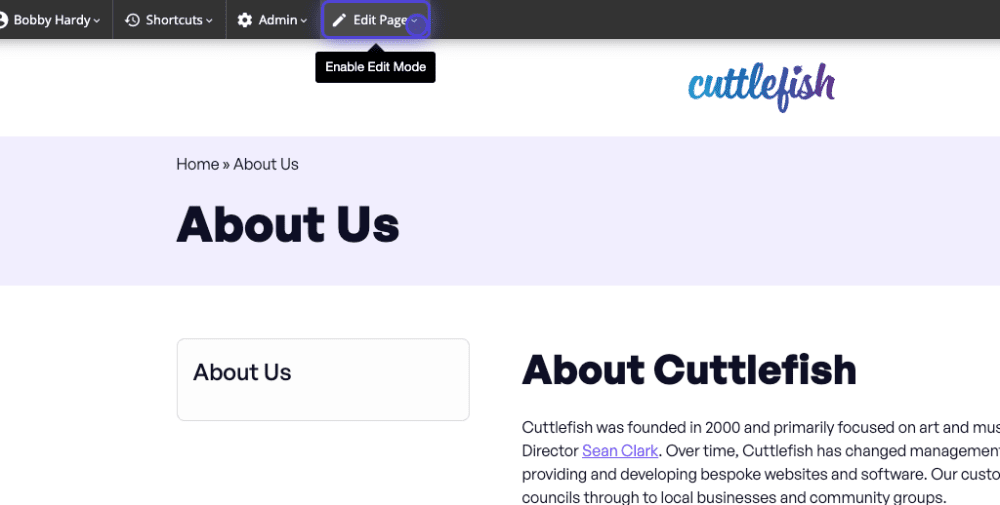Text and Writing for the Web
Once you have logged in, navigate to the page where you intend to add text to.

In the top admin bar, click on 'Edit Page'.

Once in edit mode, scroll to the bottom of the content and click 'Text'.

Once you click on the text button, a new box will pop up in your browser. Add in the information you'd like to display on your site:
- Add hyperlinks to your text by selecting the text you want to link from and clicking the chain link icon. Now simply choose a page on your own site using the page picker or type the full url of an external web page (or a document on your site - see Documents for info)
- Accessibility note: links must make sense out of context: "click here" is not a useful link, people have to track back/read around it to find out what's going on. "Take our job satisfaction survey" is far better - it describes clearly what will happen when you click the link
- Paste as plain text - if you've got your web page text in another format you can use this option (the clipboard icon with the T on it) to paste in your text - this strips out all extra formatting from other programmes which may cause your text to display oddly
- Paste from Word - a paste option specifically for content which has been written in MS Word - this will strip out unnecessary formatting but will try to leave the bits it can use (e.g. bullets)
- Bullets/Numbered lists - if your content is in a list format, use bullets to make an impact (this will also add data behind the scenes making it clear to screen-readers that this is a list)
- Spell-checker - remember to use this! Also remember it is a machine so you'll need to proof your text yourself too making sure the right words have been used e.g. there/their/they're, your/you're, it's/its, where/were/we're etc.

After completing the details for your new page, scroll down to the bottom and select 'Save' to finalise the changes.

To publish anything you have edited or added to the page, scroll to the top of your content and click 'Approve'.

Some things to keep in mind when adding text to your website...
- Don't use all capitals when you write - Online it's considered to be quite aggressive
- Consider your punctuation - Excessive exclamation marks, question marks etc. look unprofessional and childish
- Put conclusions at the beginning - People get to your web page and want to know straight away if they're in the right place. Get to the point in the first paragraph, then expand upon it.
- Make it relevant - It may be tempting to write about your brother's dog, but if it doesn't relate to your site or page topic, leave it out. Web readers want information, and unless the page is information about said dog, they really won't care, even if it is a good metaphor for what you're trying to say.
- Stick to one idea per paragraph - Web pages need to be concise and to-the-point. People don't read web pages in full, they scan them, so having short, meaty paragraphs is better than long rambling ones.
- Write short sentences - Sentences should be as concise as you can make them. Use only the words you need to get the essential information across.
- Use action words - Tell your readers what to do. Avoid the passive voice. Keep the flow of your pages moving.
- Use lists instead of paragraphs - Lists are easier to scan than paragraphs, especially if you keep them short.
- No more than seven points at a time - Studies have shown that people can only reliably remember 7-10 things at a time. By keeping your list items short, it helps your readers remember them.
- Use headings and subheadings to separate content - Sub-headings make the text more scannable. Your readers will move to the section of the document that is most useful for them, and internal cues make it easier for them to do this.
- Make your links part of the copy - Links are another way Web readers scan pages. They stand out from normal text, and provide more cues as to what the page is about. Remember, links should make sense when read on their own "click here" is not a useful link but "take our job satisfaction survey" is.
- Proofread your work - Typos and spelling errors make a site look unprofessional and can drive people away. Make sure you use the spell-checker and manually proofread everything you publish.

